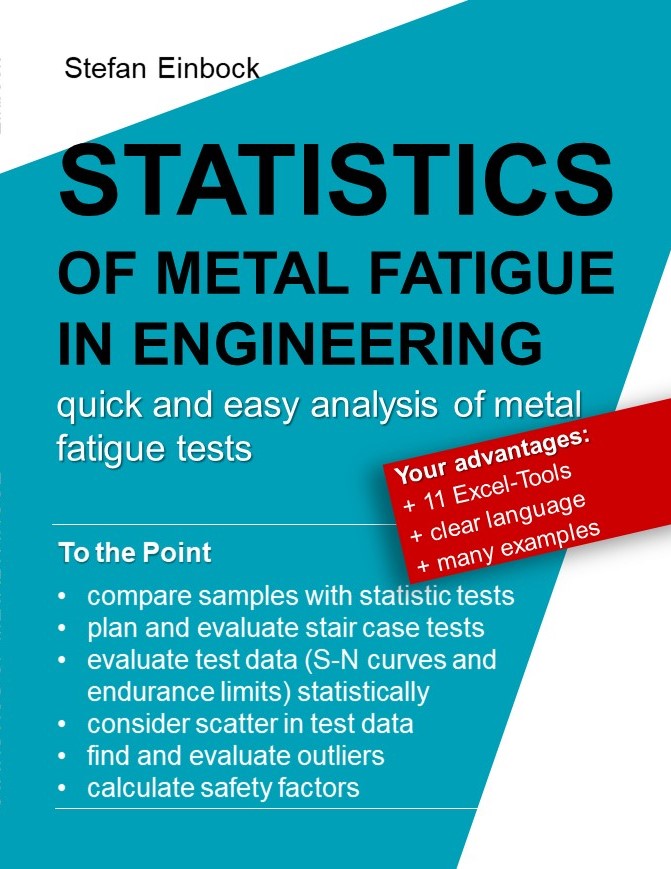
Statistics of Metal Fatigue in Engineering: Planning and Analysis of Metal Fatigue Tests
This book enables you to become familiar with the field of fatigue testing and analysis. It focuses on the basics of
- statistics for metal fatigue analysis,
- test planning and evaluation according to DIN50100 and ASTM E466 - 15.
You will learn how to
- plan and evaluate metal fatigue tests (S-N curves and endurance limits) statistically,
- calculate safety factors based on the scatter of the test data,
- evaluate endurance limits with the stair case or the probit method,
- compare samples with statistic tests like the t-Test and
- find and evaluate outliers statistically.
Planning and Analysis of Metal Fatigue Tests Made Easy!
My path to the topics of metal fatigue and especially statistics was laborious and time-consuming. I have passed on this knowledge in numerous seminars from the EinbockAKADEMIE to experienced users and beginners. Therefore, I know that familiarization with the field of fatigue is difficult, especially if it is done alongside the day-to-day business. That is why this book was created!
In arranging the content in a comprehensive manner, many illustrations are used to represent the text. A simple, clear language is consciously used (the professional routine is complicated enough!). This book focuses on the most important methods and is limited to the downright necessary mathematics. In addition, you will find helpful tips and experiences for a significant improvement of our learning efficiency.
For easy application of the methods of metal fatigue in engineering you will find useful Excel tools for your own analysis. These cover the basics of the important methods of this book and can be downloaded for free.
To consolidate the understanding, extensive exercises and step by step solutions supplement the theory.
This book is just what you need, when you …
want to understand the basics of metal fatigue tests
This book focuses on the most important methods, it gives practical tips to increase your learning efficiency and explains the basics of metal fatigue tests in a clear and simple language. Also many examples, illustrations and excel tools are given.
are looking for a quick introduction
You learn the basics of statistics like probability plots, evaluate metal fatigue test data (S-N curves) statistically using probability net and regression, evaluate endurance limits with the stair case method or the probit method and find and evaluate outliers statistically.
Directly want to use the methods
For all topics useful examples and exercises are given. For easy application, you will find useful Excel tools for your own analysis. These cover the basics of the important methods of this book and can be downloaded for free.
The content
Seven important and simple tips help you to significantly increase your efficiency in learning. This makes it easy to become familiar with the fields of statistics in a short time.
This chapter introduces all statistic basics:
- Important parameters to describe the mean values and scatter of data
- Important terms of statistics
- Background of the probability net and the density function
- Regression method 1: least square method
- Regression method 2: maximum likelihood method for cencored data
- The S-N curve.
You learn the two really important distribution functions for the evaluation of metal fatigue data and when to use them. These are
- the normal distribution
- the logarithmic normal distribution
In addition, you will understand how to deal with small sample sizes and scatter by calculating
- confidence intervals.
Discover four methods to plan and evaluate experiments to estimate the endurance limit:
- Staircase method
- Staircase method according to maximum likelihood
- Two Point Method
- Probit Method
For an easy use of the methods
- we compare all described methods
- you receive clear suggestions, when to use which method and
- many examples and exercises help you to understand the content.
See how to plan tests to estimate an S-N curve experimentally and describe the
- mean curve of the S-N curve and the
- scattering band of the S-N curve.
The following methods are presented:
evaluation of the mean curve according to the
- pearl string method and the
- the horizon method
evaluation of the scattering band of the S-N cuve in the
- HCF region
- Endurance limit region.
Two factors describe the component safety. You learn how to calculate them and how to deal with small sample sizes:
- Safety factor regarding failure probability (to describe the probability of failure).
- Safety factor regarding the sampling risk (to deal with small sample sizes).
Statistical tests help you to find outliers or to check if to test are significant different. You will understand in detail the basic of statistical tests:
- Formulation of the Null hypothesis
- Type I error: Significance
- Type II error: Power
- Test for normal distribution: the Anderson-Darling test
All topics are accompanied by excel tools.
Outliers can be extremely critical. Therefore we present you a
- simple test for outliers: the Dean-Dixon test
- bunch of methods how to deal with outliers
- useful excel tools.
Often, one wants to compare two endurance limits or S-N curves to each other. Here statistical tests can be used to check if the differences are statistically significant. You learn how to use
- The t-test in different variants
- Our Excel tools to perform a statistical test.
To consolidate the understanding, extensive exercises and step by step solutions supplement the theory you leard how to
- use Probability nets
- evaluate endurance limits and S-N curves
- calculate safety factors
- use regression methods.
Detailed step by step solutions help you to understand the exercises.

Statistics of Metal Fatigue in Engineering: Planning and Analysis of Metal Fatigue Tests
- understand and apply the statistics for metal fatigue
- using probability net and regression
- evaluate endurance limits with stair case or probit method
- evaluate S-N curves
- calculate safety factors
- assess the impact of small sample sizes
- find and evaluate outliers with excel
- compare samples with statistic tests.
The Author
 Dr.-Ing. Stefan Einbock
Dr.-Ing. Stefan Einbock
studied mechanical engineering at the Esslingen University of Applied Sciences and completed his doctoral degree in the area of fatigue at the Technical University Dresden.
He currently shares his theoretical knowledge on fatigue and reliability as a successful seminar leader for the seminars “Fatigue Calculations”, “Robust Designing and Efficient Testing of Components” and “Understanding and Implementing DRBFM”. At Robert Bosch GmbH, he heads the Competency Center for Fatigue of Metals in the Powertrain Systems division.
In order to make the knowledge of fatigue easily available to engineers, he founded the EinbockAKADEMIE. There, current topics are discussed in blog posts, books on fatigue are presented, and seminars and consultations are offered.
Error List
Have you found a mistake that has managed to creep in, despite the greatest possible care? Or would you like to give feedback? In that case too, I am happy to receive a short email.
In this case, please write me a short email at kontakt@einbock-akademie.de and as a little thank you, you will receive an additional exercise including step by step solutions.
Here you will find an error list with all actual errors:
Download error list for the metal fatigue book
Thanks a lot for your support and your feedback!
Best regards
Stefan Einbock
